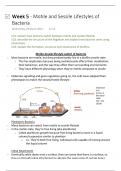Week 5 - Motile and Sessile Lifestyles of
Bacteria
Wednesday, 29 March 2023 12:15
LO1: explain how bacteria switch between motile and sessile lifestyle
LO2: describe the structure of the flagellum and explain how bacteria swim using
chemotaxis
LO3: explain the formation, structure and importance of biofilms
Motile-Sessile lifestyle switch of bacteria
- Most bacteria are motile, but they predominantly live in a biofilm sessile state
- This has implication because being motile/sessile affects their metabolism,
their behaviour, and the way they affect their surrounding environments
- They have different physiology when they're motile compared to sessile
- Elaborate signalling and gene regulation going on, the cells have adapted their
phenotypes to match the sessile/motile lifestyle
Chakrabor
ty P.,
Kumar, A.
Microbial
Cell6,
105 –122
(2019)
Planktonic Bacteria
- Many bacteria can switch from motile to sessile lifestyle
- In the motile state, they're free living (aka planktonic)
- Called planktonic growth because free living bacteria move in a liquid
column/suspension similar to plankton
○ I.e. They're both free living, individual cells capable of moving around
the liquid column
Initial Attachment
- Eventually settle down onto a surface, they can sense that there is a surface, so
they go through initial attachment by altering the expression of certain genes
- E.g. cells begin to express SenX3 gene, WhiB3 gene and SigB gene which are
involved in attachment
- This stage is still reversable to some degree, the bacteria haven't fully committed
, Initial Attachment
- Eventually settle down onto a surface, they can sense that there is a surface, so
they go through initial attachment by altering the expression of certain genes
- E.g. cells begin to express SenX3 gene, WhiB3 gene and SigB gene which are
involved in attachment
- This stage is still reversable to some degree, the bacteria haven't fully committed
yet, they can reverse back to being free living
- BUT! If surface is right, then initial attachment is followed by final attachment
Final Attachment
- Bacteria are now surrounded by a biofilm matrix that is mainly made of
polysaccharides that protects them from the immediate environment
- Final attachment is marked by the increased expression of genes that produce
that biofilm matrix (e.g. increased cellulose production) whereas metabolisms of
DNA, RNA and protein synthesis are reduced in the biofilm
- Means the cells aren't dormant, they're still active in their metabolism so
they can still divide, but not as strongly as they could in their motile state
Proliferation and Maturation
- The cells now multiply in the biofilm, the matrix of the biofilm becomes more
elaborate and the biofilm can even increase in size
- Proliferation means the sessile cells divide and create more cells, leading to
increase in thickness and density of the biofilm
- This also creates more surface area for the biofilm to attach to and grow
- Maturation means sessile cells differentiate into different types of cells with
specialised functions
- Specialisation enhances the functionality and resilience of the biofilm
- DNA, RNA and protein synthesis is down regulated when the bacteria are in a
biofilm because there's only limited space in the biofilm so only a limited [] of
nutrients available, so the bacteria don't want to reproduce a lot because that
offspring will be a competitor for the nutrients
- SO bacteria decrease their DNA, RNA and protein synthesis because they
don't want to produce another cell because that a, used up nutrients
already there (nutrients used up to produce those cellular compounds), b
produce another cell that needs exactly those nutrients that you do
- Cellulose synthesis is upregulated because that is part of the matrix of the biofilm
Dispersion
- Due to the biofilm being a confined space meaning the cells can run out of
nutrients, the bacteria now break themselves out from the biofilm matrix by
producing enzymes allowing them to degrade the matrix
- Then bacteria turn on expression of motility genes again, i.e. produce a flagella
again to swim away from the biofilm in the liquid column to a new place they can
settle down again to form another biofilm
- There are certain genes that need to be upregulated when the cells are motile
compared to when they were sessile (genes involved in attachment get
, - Then bacteria turn on expression of motility genes again, i.e. produce a flagella
again to swim away from the biofilm in the liquid column to a new place they can
settle down again to form another biofilm
- There are certain genes that need to be upregulated when the cells are motile
compared to when they were sessile (genes involved in attachment get
upregulated then)
- So bacteria with a flagellum, as soon as they attach to the surface, they shed the
flagellum as soon as they've established the biofilm
- To be motile again, they need to start producing the flagellum before they can
swim away
Q1: What is another term for motile lifestyle of bacteria?
- Planktonic
Q2: How do bacteria switch between motile and sessile lifestyle?
- One key molecule present in all bacteria associated with the switch between
motile and sessile lifestyle called cyclic-di-GMP
- So the concentration of cyclic-di-GMP signals to the cell if its in a biofilm or its
motile
- E.g. A consequence of high cyclic-di-GMP is the production of a biofilm
How do bacteria switch between motile and sessile lifestyles?
Rinaldoet al.
FEMS
MicrobiolLett,
Volume 365,
Issue 6,
March 2018,
fny029,
https://doi.or
g/10.1093/fe
msle/fny029
Second messenger: cyclic-di- - Bacteria developed a second messenger
GMP molecule called cyclic-di-GMP, it is what
(cyclic di-guanosine tells the cell whether to be motile or
monophosphate)inside the cell; sessile
fast diffusion; integration of
multiple signals - A second messenger molecule (SSM) is a
signalling molecule produced inside the cell,
Low levels of cyclic-di-GMP (in contrast to primary messengers which
Promotes Motility and Virulence are typically signalling molecules outside
the cell)
High levels of cyclic-di-GMP - SSM is fast diffusing inside the cytoplasm




